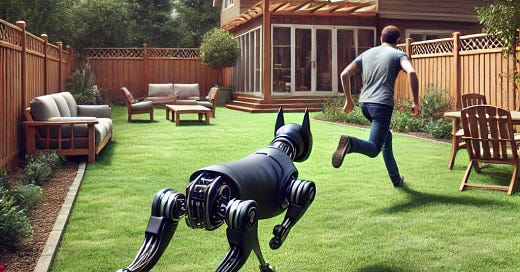Imagine being in your backyard when your neighbor’s robotic dog approaches. Like a real dog, you’re uncertain of its intentions—until it begins to chase you. Suddenly this is no game.
The future is no longer coming; it’s here. Autonomous robots, self-driving cars, and AI-controlled machines have moved from research labs and factories into our public spaces. They now work alongside humans, making critical decisions in real time. But with this rapid evolution comes a growing, often-overlooked risk: like any computer system, these machines can be hacked, hijacked, and weaponized against us.
Operational Technology: The Hidden Vulnerability
At the heart of this new risk lies Operational Technology (OT)—systems that control physical equipment like power grids, robots, hospital machines, and port cranes. Unlike IT security, which focuses on protecting data and software, OT security is about preventing cybercriminals from manipulating machinery. A hacked server might result in data theft; a hacked autonomous vehicle or robotic system could lead to catastrophic outcomes.
The threat isn’t hypothetical. Governments already worry about hidden backdoors in foreign-made hardware, like Huawei chips embedded in critical U.S. infrastructure. Corporate networks face daily cyberattacks—why should OT systems, which power essential machinery, be any different? The stakes are clear: cybersecurity must evolve at the speed of automation.
The Need for Real-Time Cyber Defense
OT security differs fundamentally from traditional cybersecurity. While a software breach might take hours, days and even months to detect, a compromised machine could cause harm in milliseconds. Defense must be instantaneous. Yet today’s cybersecurity systems lack the speed, scale, compute and accuracy required to address this challenge. For instance, today’s most advanced cyber security systems have an error rate of 40-60%. Hard to fathom, but true.
Get Ready—You’re Going to Be Hearing a Lot About This
The machines are here. The question is—who’s really in control?
In the race between innovation and security, one thing is clear: cyber threats aren’t slowing down. Autonomous fleets, AI-driven security bots, self-thinking drones—every breakthrough brings incredible possibilities… and terrifying risks.
This isn’t some far-off sci-fi scenario. It’s happening now.
Future cyber attacks won’t just steal data—they will hijack machines in real-time. It won’t be a breach you read about later; it will be something you experience in the physical world. And when that moment comes, the world will finally understand:
Cybersecurity isn’t just about protecting information anymore. It’s about protecting reality itself.





